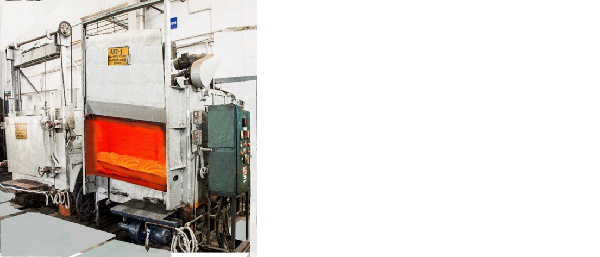
Annealing
This process is employed to soften the material before machining or for desired crystal structure in the steel.
Annealing is a heat treatment process used to alter the physical and mechanical properties of a material, typically metals and alloys. The primary goal of annealing is to reduce hardness, improve ductility, relieve internal stresses, and restore the material’s workability after it has been deformed by processes like forging, rolling, or welding.
How It Works
Heating: The material is heated to a specific temperature, usually above its recrystallization
temperature
for metals like steel, this is typically around 930֯F to 1650֯F (500°C to 900°C).
The material is held
at this temperature for a period, allowing the atoms to rearrange themselves and
eliminating internal stresses.
Holding (Soaking): The material is held at the annealing temperature for a certain duration (the
"soaking
time"). This allows diffusion processes to take place, where the material’s crystalline structure is
homogenized.
Soaking time depends on the size of the component and the type of material.
Cooling: Cooling:After holding, the material is cooled slowly, usually in a furnace or ambient air,
to allow the
recrystallized grains to grow and stabilize.
Slow cooling is essential to prevent the formation of new
stresses and ensures a soft, ductile
microstructure.
Types of Annealing
Full Annealing: The material is heated to a temperature above its recrystallization point and then
cooled
slowly. This produces a softer, more ductile material with large grains, making it easier to work with.
Stress-Relief Annealing: Performed below the recrystallization temperature to relieve internal
stresses
caused by machining, cold working, or welding without altering the microstructure of the material.
Spheroidizing Annealing: Nitriding improves the fatigue life of components, making them more
reliable under cyclic loads.
Used for steels, where prolonged heating below the eutectoid temperature
produces spherical carbides in the microstructure, making the steel softer and more machinable.
Recrystallization Annealing: Applied after cold working, it restores the material's ductility by
eliminating
dislocations that formed during deformation.
Benefits
Increased Ductility: Annealing improves ductility, making metals easier to bend, shape, or machine
without breaking.
Reduced Hardness: The process softens metals, which reduces hardness and brittleness, allowing them
to undergo further forming or shaping.
Improved Workability: By relieving internal stresses, annealing makes materials more workable for
subsequent manufacturing processes like stamping, drawing, or rolling.
Stress Relief: Annealing removes residual stresses caused by previous manufacturing processes,
reducing the likelihood of warping, cracking, or material failure during use.
Improved Electrical Conductivity: For certain metals like copper, annealing improves electrical
conductivity by reducing impurities and internal stresses.
Refined Grain Structure: Annealing can homogenize and refine the grain structure of a material,
improving its mechanical properties such as toughness and strength.
Enhanced Toughness: Annealed materials are tougher and less likely to crack under mechanical loads or
impacts.
Typical Materials Used
Steels (Carbon and Alloy): Annealing is widely used in the steel industry to improve ductility,
relieve
stresses, and soften the material for further processing.
Copper and Copper Alloys: Copper is often annealed to improve electrical conductivity and restore
ductility after cold working.
Aluminum and Aluminum Alloys: Aluminum can be annealed to remove work hardening effects,
enhance formability, and restore ductility.
Brass: Annealing is used to soften brass after cold working processes such as drawing or rolling,
making
it easier to shape.
Stainless Steels: Annealing helps to restore ductility, especially after cold deformation, and to
relieve
internal stresses in stainless steel components.
Titanium Alloys: Annealing can improve toughness and stress resistance in titanium, making it more
suitable for aerospace and medical applications.
Applications
Automotive Industry
Car bodies and frames: Annealed steel and aluminum are used in the forming of body panels and structural components to improve ductility and reduce the risk of cracking.
Gears and shafts
Annealing relieves stresses from manufacturing processes to ensure the longevity of engine components.
Metalworking Industry
Machining and stamping: Annealed metals are easier to cut, shape, or stamp, reducing tool wear and extending tool life
Forging
Annealing improves the formability of metals, allowing them to be forged into complex shapes.
Electrical Industry
Copper wire and cables: Annealing enhances the ductility and electrical conductivity of copper, making it suitable for use in electrical wiring.
Aerospace Industry
Aircraft components: Annealing is used on aluminum and titanium alloys to improve toughness, reduce internal stresses, and ensure performance under high-stress conditions.
Construction Industry
Structural steel: Annealed steel is used in construction to improve its ductility, making it easier to weld and form into structural components
Piping
Annealed stainless steel and copper piping are used in plumbing and heating applications due to their improved malleability and toughness
Medical Devices
Surgical instruments: Annealed stainless steel is used to produce tough, corrosion-resistant surgical instruments and medical implants.
Consumer Goods
Metal furniture and appliances: Annealing is used to soften metals like steel and aluminum, making them easier to form into shapes for use in household goods like appliances, furniture, and cookware.
Customers Reviews

John Doe
Diam amet duo labore stet elitr invidunt ea clita ipsum voluptua, tempor labore accusam ipsum et no at. Kasd diam tempor rebum magna dolores sed eirmod

Kerald Bob
Diam amet duo labore stet elitr invidunt ea clita ipsum voluptua, tempor labore accusam ipsum et no at. Kasd diam tempor rebum magna dolores sed eirmod